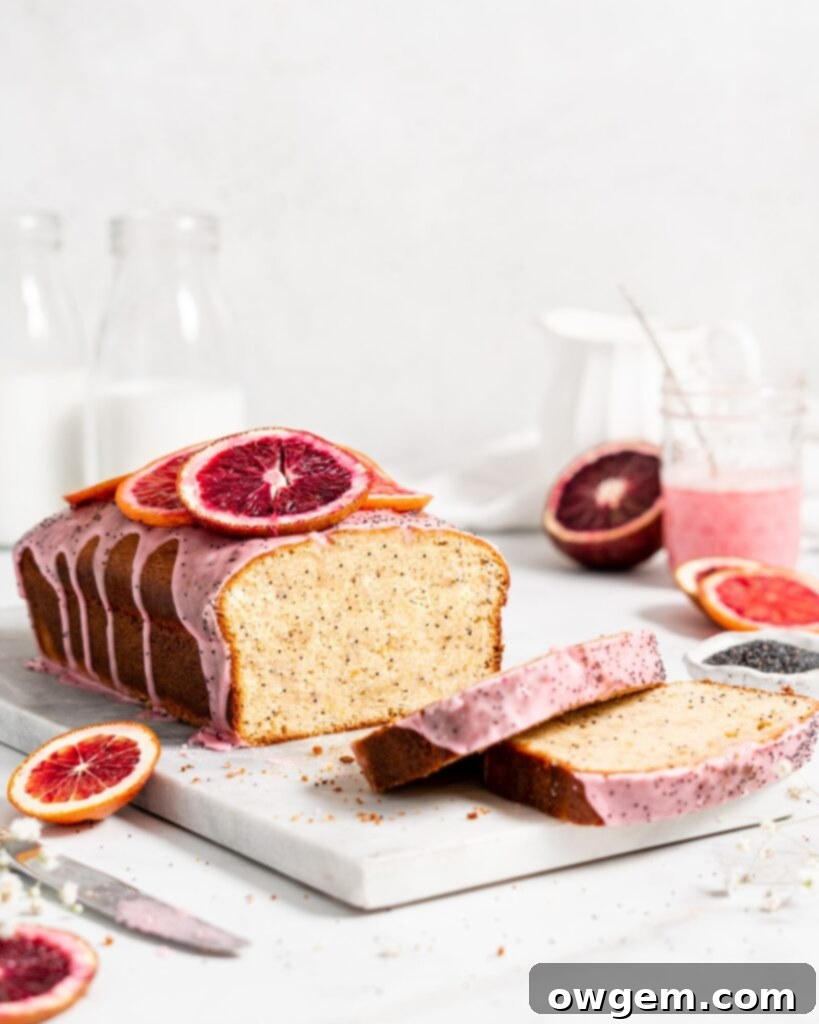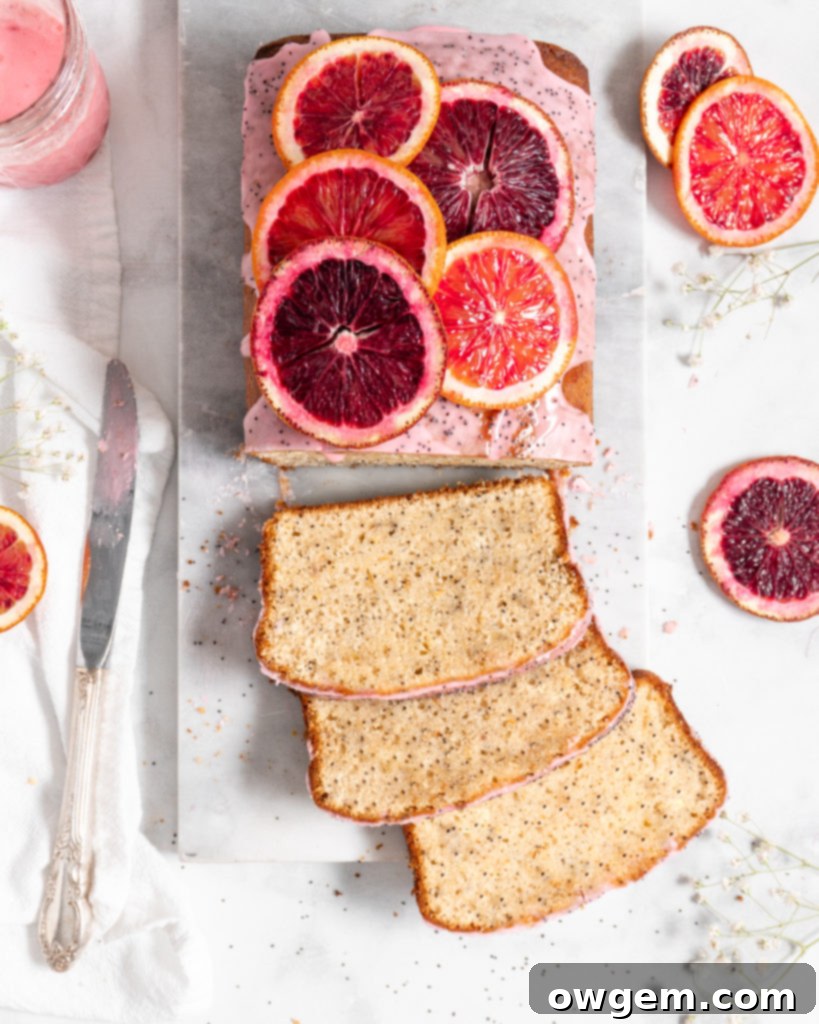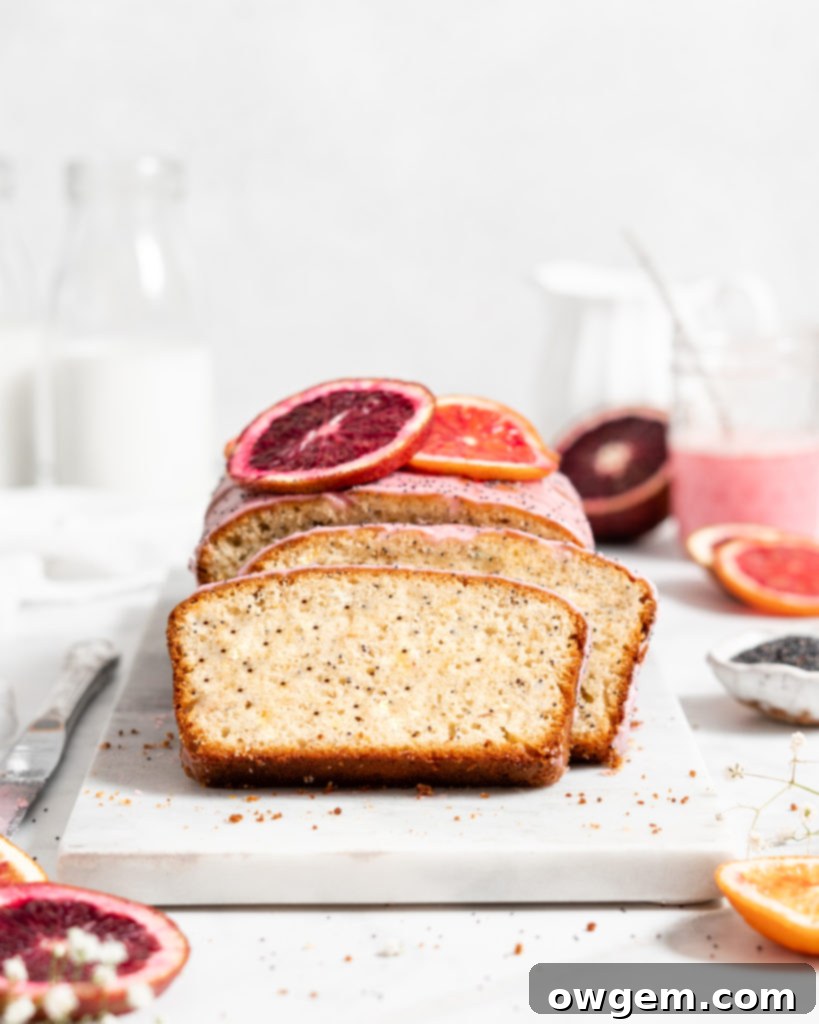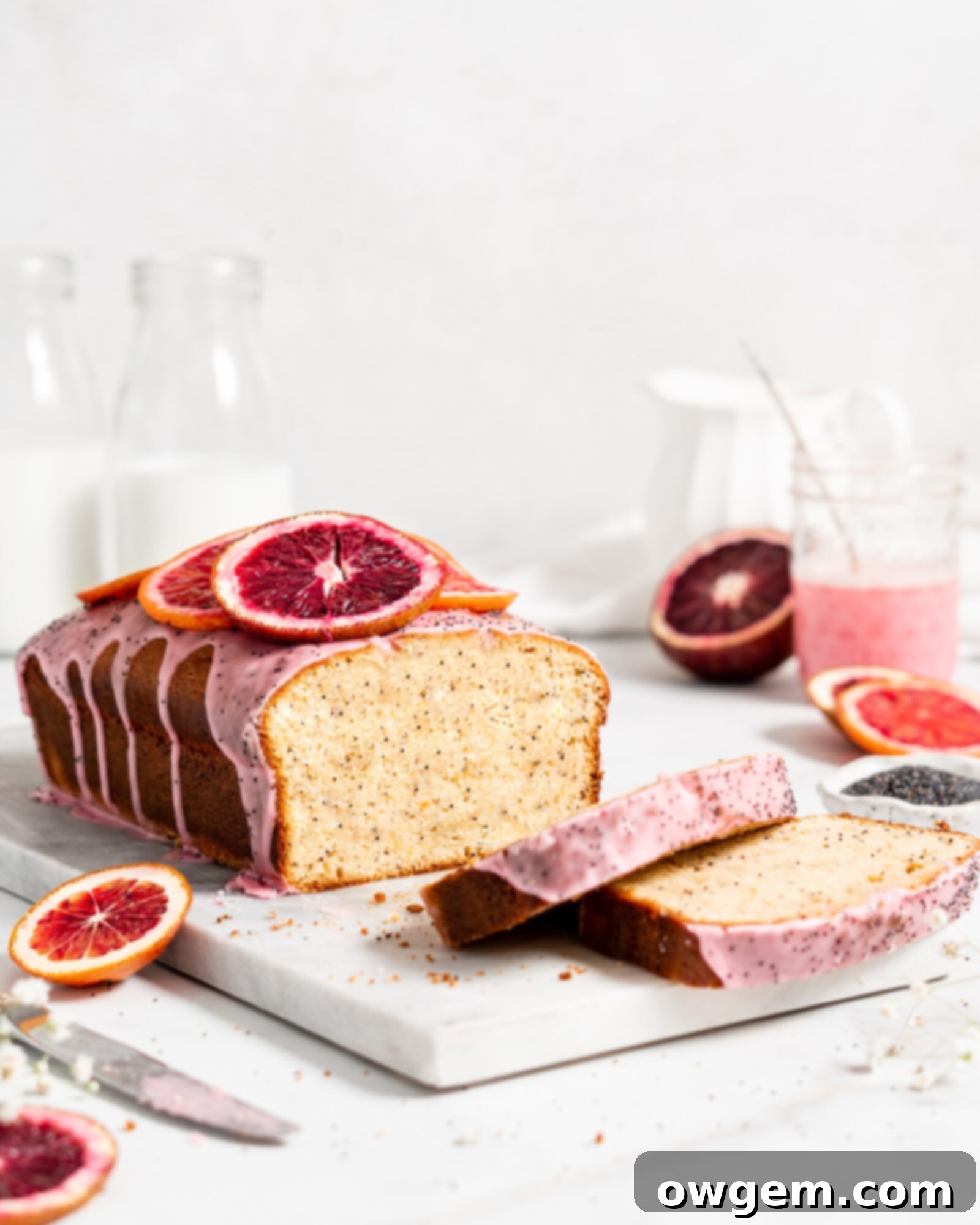Sensational Blood Orange Poppy Seed Loaf: Your Ultimate Guide to Citrus Perfection
Step aside, classic lemon loaf, because we’re thrilled to introduce the undisputed star of citrus season: this incredibly moist and flavorful Blood Orange Poppy Seed Loaf! This delightful loaf perfectly captures the essence of winter’s vibrant citrus. It boasts a beautifully tender crumb, generously infused with the bright, sweet-tart juice and aromatic zest of blood oranges, creating an unparalleled citrus experience. To elevate it further, each slice is crowned with a luscious, sweet blood orange glaze, making every bite a truly exquisite treat. Whether you’re a seasoned baker or just starting, this recipe promises to deliver a show-stopping loaf that’s both easy to make and utterly irresistible.

Why This Blood Orange Poppy Seed Loaf Is a Must-Try
During the colder months, when blood oranges are at their peak, this loaf brings a burst of sunshine to your kitchen. It’s more than just a cake; it’s an experience. The striking deep red hue of the blood oranges not only adds a beautiful visual appeal but also a unique flavor profile that’s sweeter and less acidic than regular oranges, with subtle berry-like undertones. Paired with the delicate crunch of poppy seeds and a hint of warm spice, this loaf offers a sophisticated yet comforting taste that will have everyone asking for the recipe. It’s perfect for breakfast, brunch, afternoon tea, or as a light dessert. Plus, it makes for a fantastic edible gift!
Essential Ingredients for Your Blood Orange Poppy Seed Loaf
Crafting this exquisite loaf requires a thoughtful selection of ingredients, each playing a crucial role in achieving its perfect texture and vibrant flavor. Here’s a deeper dive into what you’ll need:
Blood Oranges: These are the true heroes of our recipe. We’ll be utilizing both the fresh juice and the aromatic zest to ensure every morsel of the loaf is imbued with maximum blood orange flavor. The zest holds most of the fruit’s essential oils, providing an intense citrus aroma, while the juice contributes moisture and that characteristic sweet-tart tang. Always opt for fresh blood oranges when they are in season for the best results!
Poppy Seeds: Black poppy seeds are the ideal choice here, sometimes also referred to as ‘blue’ poppy seeds. They add a delightful, subtle nutty flavor and an appealing texture that contrasts beautifully with the soft crumb of the loaf. Don’t skip them, as they are integral to the classic poppy seed loaf experience.
Cardamom: This often-underestimated spice brings a magical touch to the loaf. Cardamom is known for its slightly floral, subtly citrusy, and warm notes. A small quantity is used in this recipe to enhance and deepen the natural flavor of the blood orange without overpowering it. It creates a harmonious balance, adding complexity and sophistication.
Oil: A neutral-flavored vegetable oil, such as canola oil, is crucial for this recipe. Unlike butter, which can make loaves dense, oil provides unparalleled moisture, ensuring a tender, soft, and melt-in-your-mouth crumb that stays fresh for longer. It’s the secret to that perfectly delicate texture.
Eggs: Eggs serve multiple purposes in baking: they act as a binder, holding the ingredients together, and contribute to the loaf’s structure and richness. They also help achieve that lovely golden-brown crust and add a touch of lift, ensuring a light and airy texture.
Sugar: Plain granulated white sugar is perfect for this recipe. Beyond sweetness, sugar plays a vital role in tenderizing the loaf and helping achieve a beautiful crust. In this recipe, we’ll first rub the sugar with the blood orange zest – a technique that significantly amplifies the citrus flavor, as explained in detail below.
Sour Cream: The addition of full-fat sour cream is a game-changer. It not only hydrates the batter, resulting in an exceptionally moist loaf, but also introduces an extra dimension of richness and a subtle tangy flavor that complements the sweet blood orange beautifully. If sour cream isn’t available, high-fat plain yogurt or buttermilk can be excellent substitutes, providing similar moisture and tang.
Pantry Staples: These foundational ingredients complete our dry mixture. All-purpose flour provides the primary structure; baking powder acts as the leavening agent, ensuring the loaf rises and achieves its fluffy texture; salt balances the sweetness and enhances all the other flavors; and vanilla extract adds a comforting warmth and depth that rounds out the bright citrus notes.

The Star Ingredient: What Are Blood Oranges?
Blood oranges are a fascinating and visually stunning variety of orange, characterized by their deep red, almost maroon-colored flesh. This captivating color is not just for show; it’s due to the presence of anthocyanin, a naturally occurring pigment also found in fruits like blueberries, raspberries, and cherries, as well as many flowers. The intensity of the red hue can vary greatly, from a subtle blush or slight streaks within the segments to a fully saturated, crimson-stained pulp throughout the entire fruit.
Beyond their striking appearance, blood oranges offer a unique flavor profile that sets them apart from common navel or Valencia oranges. They are typically sweeter, with a distinct flavor that often includes notes of raspberry or cranberry, alongside the familiar citrus tang. They also tend to have fewer seeds, making them more enjoyable to eat and easier to work with in recipes. Popular varieties include ‘Moro’ (the darkest), ‘Tarocco’ (often considered the sweetest and most seedless), and ‘Sanguinello’. Originating in Sicily and Spain, these oranges thrive in Mediterranean climates, where cool nights and warm days enhance their anthocyanin development, leading to their vibrant coloration. Enjoying blood oranges in season means indulging in their peak flavor and nutritional benefits, which include high levels of Vitamin C and antioxidants.
The Secret to Intense Citrus Flavor: Zest Rubbing Technique
One of the key steps in this recipe that truly elevates the blood orange flavor is the technique of rubbing the citrus zest with sugar. If you’re wondering why this seemingly simple step is included, it’s because it’s a powerful method for maximizing the flavor and fragrance of any citrus zest!
The vibrant taste and intoxicating aroma of citrus zest come from the tiny pockets of essential oils located just beneath the surface of the peel. These oils are packed with concentrated flavor. By rubbing the zest with sugar, we create an abrasive action that effectively ruptures these oil glands, releasing the essential oils directly into the sugar. The sugar, with its grainy and uneven texture, acts as a perfect natural abrasive. As you rub, the sugar crystals physically extract and absorb these flavorful oils, becoming infused with the intense citrus essence.
How to execute this technique for best results: After finely zesting your blood oranges, add the zest to the granulated sugar in a mixing bowl. Then, using your fingertips (or the back of a spoon), firmly rub the zest into the sugar for a few minutes. You’ll know it’s properly rubbed when the sugar begins to take on a slightly orange (or reddish-orange from the blood orange) hue and becomes incredibly fragrant. This simple step ensures that the loaf will have an exceptionally bright and pronounced blood orange flavor throughout, making a significant difference to the final product. It’s a small effort with a huge payoff in taste!

How to Bake the Perfect Blood Orange Poppy Seed Loaf
Creating this tender and flavorful Blood Orange Poppy Seed Loaf is a straightforward process that yields impressive results. Follow these steps carefully for a beautifully baked treat:
1. Prepare Your Zest-Infused Sugar: Begin by combining the granulated sugar and the blood orange zest in a medium-sized bowl. Use your fingertips to rub the zest and sugar together vigorously for about 2-3 minutes until the sugar is uniformly colored and intensely fragrant. This crucial step extracts the maximum flavor from the zest. Set this aside.
2. Whip Eggs and Flavorings: In the bowl of your stand mixer fitted with the paddle attachment, add the large eggs, the fragrant zest/sugar mixture, and vanilla extract. Beat these ingredients together on high speed for approximately 3-4 minutes. The mixture should transform into a light, fluffy, and visibly tripled in volume consistency, indicating proper aeration.
3. Incorporate Liquids: Reduce the stand mixer speed to medium-low. Slowly and steadily drizzle the vegetable oil into the egg mixture while the mixer continues to run. This gradual addition ensures the oil is fully emulsified. Once all the oil is incorporated, pour in the fresh blood orange juice and continue to beat the mixture for another 30 seconds to ensure everything is well combined.
4. Whisk Dry Ingredients: In a separate, clean mixing bowl, combine the all-purpose flour, baking powder, table salt, and cardamom. Use a whisk to thoroughly blend these dry ingredients together. This step helps distribute the leavening and spices evenly throughout the flour, preventing lumps and ensuring a consistent rise.
5. Alternate Wet and Dry Additions: With the stand mixer on its lowest speed, begin adding the dry ingredients to the wet mixture in three alternating additions, with the sour cream in between. Start by adding one-third of the dry mixture, and beat until just combined (be careful not to overmix). Next, add half of the full-fat sour cream, and beat until just incorporated. Continue this pattern: add the second third of the dry ingredients, then the remaining sour cream, and finally, the last portion of the dry ingredients. Always beat only until the ingredients are just combined after each addition to prevent developing the gluten too much, which can result in a tough loaf.
6. Fold in Poppy Seeds: Once your batter is smooth and all wet and dry ingredients are incorporated, gently fold in the poppy seeds by hand using a spatula. Give the batter one final, quick mix – just enough to ensure the poppy seeds are evenly dispersed throughout the batter. Overmixing at this stage can also lead to a dense loaf.
7. Bake to Perfection: Pour the luscious Blood Orange Poppy Seed Loaf batter into your prepared 9×5 inch loaf pan (greased and floured, or lined with parchment paper for easy removal). Place the pan into your preheated oven and bake as directed. The loaf is done when a wooden skewer or toothpick inserted into the center comes out clean. Once baked, allow the Blood Orange Poppy Seed Loaf to cool completely in the pan on a wire rack before attempting to glaze it. Glazing a warm loaf will cause the glaze to melt and run off.
Crafting the Irresistible Blood Orange Glaze
No Blood Orange Poppy Seed Loaf is truly complete without its signature glaze. This simple yet incredibly flavorful glaze adds a beautiful sheen, extra moisture, and an additional burst of citrus sweetness that ties the entire dessert together. It’s quick to make and provides a stunning finish.
To prepare the glaze, you’ll need two main ingredients: confectioners’ sugar (also known as powdered sugar or icing sugar) and freshly squeezed blood orange juice. The key is to achieve the right consistency – thick enough to cling to the loaf but fluid enough to drizzle or spread smoothly.
Simply combine the confectioners’ sugar in a bowl. Gradually add the blood orange juice, starting with 2 tablespoons, and whisk continuously until a smooth, pourable glaze forms. If the glaze is too thick, add a tiny bit more juice (a quarter teaspoon at a time) until it reaches your desired consistency. If it becomes too thin, whisk in a little more confectioners’ sugar. The goal is a glaze that cascades elegantly down the sides of the loaf without being too runny. Once the loaf has cooled completely, you can either pour the glaze directly over the top, letting it drip organically, or pipe it on for a more controlled design. For an extra touch of visual appeal and texture, consider sprinkling a few additional poppy seeds over the wet glaze before it sets.

Get the Recipe: Blood Orange Poppy Seed Loaf
Pin
Rate
Ingredients
Blood Orange Poppy Seed Loaf
- 2 ¼ cups (270g) All Purpose Flour, measured correctly †
- 1 ½ tsp Baking Powder
- 1/2 tsp Table Salt
- 1/2 tsp Cardamom
- 1 ½ cups (300g) Sugar
- Zest of 2 Blood Oranges
- 3 Large Eggs
- 1 ½ tsp Vanilla Extract
- 3/4 cup (180ml) Vegetable Oil
- Juice of 3 Blood Oranges
- 3/4 cup (180ml) Full Fat Sour Cream
- 1 tbsp (8g) Poppy Seeds
Blood Orange Glaze
- 2 cups (240g) Confectioners Sugar
- 2-3 tbsp (30-45ml) Freshly Squeezed Blood Orange Juice
Equipment
-
Stand mixer
-
9×5 inch Loaf Pan
-
Mixing Bowls
-
Whisk
-
Zester
Instructions
Blood Orange Poppy Seed Loaf
-
Preheat your oven to 350°F (175°C). Prepare a 9×5 inch loaf pan by lightly greasing it with cooking spray or butter, then lining it with parchment paper, leaving an overhang on the long sides for easy removal. In a medium to large mixing bowl, combine the all-purpose flour, baking powder, cardamom, and salt, then whisk thoroughly to ensure they are well combined. In a separate bowl, add the sugar and blood orange zest, then rub the zest into the sugar using your fingers until the sugar takes on an orange tint and becomes very fragrant. Set aside.
-
In the bowl of a stand mixer fitted with the paddle attachment, add the large eggs, the zest-rubbed sugar, and vanilla extract. Beat these ingredients on high speed for approximately 3-4 minutes. The mixture should become thick, pale, fluffy, and notably tripled in volume. Next, with the mixer on medium speed, slowly drizzle in the vegetable oil until fully incorporated. After all the oil has been added, pour in the blood orange juice and beat on high for an additional minute to ensure everything is thoroughly combined and emulsified.
-
Reduce the mixer speed to low. Add the whisked dry mixture to the stand mixer in three additions, alternating with the sour cream. Begin with one-third of the dry ingredients, beating until just combined. Then add half of the sour cream, mixing until just incorporated. Continue with the second third of the dry ingredients, then the remaining sour cream, and finally, the last portion of the dry ingredients. With the very last dry addition, gently fold in the poppy seeds. Beat only until the batter is just smooth and no streaks of flour remain. Avoid overmixing to keep the loaf tender. Pour the prepared batter into the lined loaf pan. Bake in the preheated oven for around 50-60 minutes, or until a wooden skewer or toothpick inserted into the center of the loaf comes out clean. Once baked, allow the loaf to cool completely in the pan on a wire rack before attempting to glaze.
Blood Orange Glaze
-
To make the glaze, add the confectioners’ sugar to a small bowl. Gradually whisk in the freshly squeezed blood orange juice, starting with 2 tablespoons. Continue to whisk until you achieve a smooth, pourable consistency. The glaze should be thick enough to coat the back of a spoon but still fluid. If it’s too thick, add a tiny bit more juice (a quarter teaspoon at a time); if too thin, add a little more confectioners’ sugar. Once the loaf is completely cooled, pour or pipe the vibrant glaze over the top, letting it drip enticingly down the sides. For an optional decorative touch, sprinkle with additional poppy seeds while the glaze is still wet.
Expert Baking Tips & Troubleshooting
Achieving a perfect Blood Orange Poppy Seed Loaf is well within reach with a few key tips and an understanding of common pitfalls:
- Measure Flour Correctly: The most common baking mistake is over-measuring flour. Always spoon flour into your measuring cup and then level it off with the back of a knife. Alternatively, use a kitchen scale for the most accurate measurement (270g for 2 ¼ cups). Too much flour will result in a dry, dense loaf.
- Don’t Overmix the Batter: Once you add the dry ingredients, mix only until just combined. Overmixing develops gluten, leading to a tough, chewy texture rather than a tender one. A few small lumps of flour are better than an overmixed, smooth batter.
- Room Temperature Ingredients: Ensure your eggs, sour cream, and blood orange juice are at room temperature. This helps them emulsify better with the other ingredients, creating a smoother, more uniform batter and a finer crumb.
- Test for Doneness: Baking times can vary depending on your oven. Always test the loaf’s doneness by inserting a wooden skewer or toothpick into the center. If it comes out clean or with a few moist crumbs attached, it’s ready. If it’s still wet, continue baking for 5-minute increments.
- Cool Completely Before Glazing: Patience is key here! Glazing a warm loaf will cause the glaze to melt and create a soggy crust. Allow the loaf to cool completely on a wire rack for at least 1-2 hours before applying the glaze.
- Pan Preparation is Crucial: Don’t skip greasing and lining your loaf pan with parchment paper. This prevents sticking and ensures easy removal, maintaining the loaf’s beautiful shape.
Serving Suggestions and Storage
This Blood Orange Poppy Seed Loaf is incredibly versatile and delicious in many ways. Serve it for breakfast alongside a cup of coffee or tea, as an elegant addition to a brunch spread, or as a delightful afternoon snack. It’s also sophisticated enough to be a light dessert after dinner. For an extra touch, you can serve slices with a dollop of whipped cream, a scoop of vanilla ice cream, or a side of fresh berries.
Storage: To maintain its freshness, store the glazed loaf at room temperature in an airtight container for up to 3-4 days. The glaze helps seal in moisture. If your kitchen is particularly warm, or if you prefer, you can store it in the refrigerator for up to a week. Just note that chilling can slightly alter the texture; bring it back to room temperature before serving for the best experience. For longer storage, slices of the unglazed loaf can be wrapped tightly in plastic wrap and then aluminum foil, then frozen for up to 2-3 months. Thaw at room temperature and then glaze before serving.
We hope you fall in love with this Blood Orange Poppy Seed Loaf as much as we have. Its vibrant flavors and tender crumb make it a truly special bake that celebrates the best of citrus season. Happy baking!


